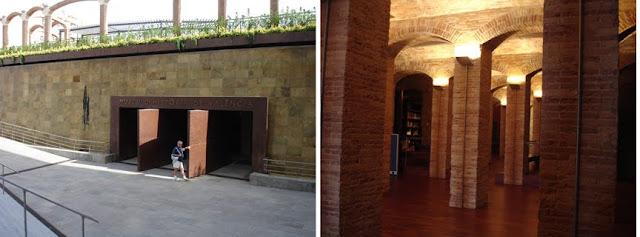Yesterday (Tuesday) our first challenge was to locate where to buy a 3 day bus/metro pass. We have a car at our disposal here which we will use extensively outside of the city but it looked easier to navigate around the city using public transportion. This had worked well for us in Nice. Well, it took us over two hours and much walking to locate where we could buy the bus passes. We even went to the administrative offices for the bus company in the center of the old town. They didn't sell them but they did actually point us to a tobacco shop which did sell us the precious tickets. Phew!
Our first sight-seeing target was the market. Unlike in France where they set up and take down everything on market day, this is a permanent building (completed in 1928) with permanent stalls (hundreds of them!). The guidebook says it is one of the largest markets in Europe and I believe it. It is hard to capture in pictures.
Inside where tons of fresh produce, meats and fish stalls along with bakery and candy stores. It was pretty amazing but all we bought was a small purple onion for sandwichs. It cost 10 cents. I think the woman who sold it to us was amused by our purchase.
As we left the market we kept stumbling across a lot of very interesting looking buildins. Nothing was labelled! We went into one magnificent building, wandered around, took pictures and then later looked up what we had seen.
Larry has been studying Spanish for the past 5-6 months. Specifically he is learning Latin Americna Spanish, but there isn't that much difference from Castillon so we hoped he would be understood. Well, as it turns out, here in Valencia, they have maintained their own version of Spanish - called Valencian. It is difficult enough to try to communicate in a new language, but we can't even tell which language they are using! This also makes navigating a little difficult as all the streets in the old town are labelled in Valencian and sometimes also Spanish. I found this frustrating as the navigator. All in all, I have to say that I am impressed that he has been able to get us around as well as he has. I speak no Spanish beyond "gracias" and "ola".
So, now that we had the bus passes, we found lunch at a nearby square which turned out to be a beautiful plaza with lovely buildings around it including the Chapel of Our Lady of the Abandoned built in 1652.
The Chapel was incredibly ornate and has a huge statute of the Virgin Mary. The ceiling was beautifully painted in a series of religious scenes - none of which we could figure out. There was a little connecting bridge to the cathedral which reminded me of the bridge of sighs in Venice.
Having admired the chapel we headed for the front of the cathedral. It was built in the thirteenth century and was absolutely huge inside. Less ornate than the chapel next door but very impressive. It has a very tall tower (Miguelete) attached to it which you can climb up for 3 euros but it is 207 steps. My knees begged me not to do it despite the promise of wonderful views.
Since pretty much everything closes from two to four, we headed home (by bus) to go to the grocery store and rest. We successfully located a really nice grocery store, Consum, about two blocks away. Here, as in France, we needed to be careful when we shopped as we have to be able to carry what we buy. The apartment we are in has a rolling grocery sack which was very useful and we managed to secure food for a home cooked dinner (for Wednesday) as well as snacks and sodas and some paper products.
Once somewhat rested and restored, we ventured back out to try out our navigational skills and bus passes on the buses and metros - taking 3 of them to get to the Museum of History of Valencia. It was a very, very interesting well presented museum in an amazing location - a water cistern built in the nineteenth century. It was a maze of pillars and arches - difficult to capture in a photo.
Of course everything was described in both forms of spanish, but they gave us an English guide which we read as we went along. We spent several hours there learning the fascinating, varied history of this lovely city founded by the romans, conquered by the Moors, run by the Visigoths, reconquered several times by various other forces until it finally became a region of Spain. We learned that it was the Moors who brought water technology to the city - establishing irrigation systems that allowed them to start to farm the region. We also learned about the flood of the Turia river which ran through the town. A terrible flood occurred in the late 1950's. Since then the river has been re-routed outside of the city and the dry old river bed has been turned into the largest city park anywhere in Spain.
This is turning out to be a very interesting city, indeed!





No comments:
Post a Comment